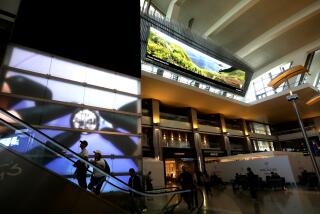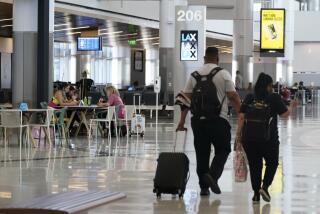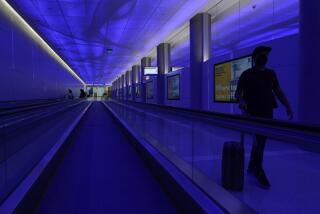Riley Terminal Redesign Will Aid Access for Handicapped
- Share via
COSTA MESA — While denying that state codes were violated, officials at John Wayne Airport nevertheless have agreed to make several design changes at the new Thomas F. Riley Terminal to provide easier access for handicapped travelers.
The most extensive redesign will be to handicapped stalls in restrooms, where doors will be made to swing out instead of in and will be equipped with self-closing devices.
Some 36 handicapped stalls in parking garages will be restriped in blue to help make them more identifiable. The stalls also will undergo minor renovation to remove baggage racks that were positioned too closely to stalls and to add tire bumpers.
County building officials said they suggested the measures to airport managers following an inspection of the terminal just before its September opening.
The inspection came in response to concerns raised by a state consultant who, along with representatives of local disabled groups, toured the terminal and determined that several state codes mandating accessibility for the handicapped had been violated.
All of the alleged violations fall under Title 24 of the California Building Code, which lists specific requirements to accommodate individuals with visual or hearing impairments or those confined to a wheelchair.
County building inspector Floyd McLellan said Thursday that the inspection team did not find any “serious violations” of state codes but did find areas that could be made more readily accessible.
However, the consultant, Ronald Mincer, on Thursday said the codes are explicit and the airport is in violation of several. He suggested that airport and county officials are claiming a different interpretation of the codes to deflect further criticism of the terminal project, which was plagued with construction problems before opening.
“I think the state would back me up,” said Mincer, a member of the Community Access Network, which advises the state on handicapped accessibility.
Despite disagreement over interpretation of codes, Mincer said meetings with county building officials have been productive.
“I am satisfied that the features that create a problem for access will be taken care of,” said Mincer, himself a quadriplegic. “Some other features are not a major problem, and I would not want to make a fuss over them.”
Redesign of some features that were alleged to be in violation of state guidelines are still being negotiated, Mincer said. The most important and potentially costliest is adding more curb cuts or wheelchair ramps at entrances and pathways.
At the new terminal, such ramps are located only at the four main entrances to the building, while state codes require that they be placed “wherever a pedestrian path crosses a curb.”
Mincer said he would like to see at least three more ramps added to both the lower and upper levels of the terminal.
McLellan said inspectors have not determined a need for more curb cuts but said additions might be considered.
Other features of access that Mincer determined were in technical violation of state codes--including pay phones and drinking fountains that slightly exceed height limitations--will remain unaltered by mutual agreement, he said.
But Mincer is pressing building inspectors to require that each restroom be equipped with an additional sink, mirror and soap dispenser for the handicapped.
Airport officials have also agreed to repaint pedestrian traffic control poles to include contrasting stripes to aid the visually impaired and to add protective guards to fire alarm pull boxes.
No cost estimates on the renovations were immediately available.
Brendo Premo, executive director of the Dayle McIntosh Center for the Disabled in Anaheim toured the terminal with Mincer before it opened and said she was satisfied with the progress made to correct access problems.
“As long as things are moving and not standing still, I’m pleased,” she said. “Overall, I love the airport--its size and signage. It’s just a few little things that could have been avoided had (airport officials) sought our input.”
More to Read
Sign up for Essential California
The most important California stories and recommendations in your inbox every morning.
You may occasionally receive promotional content from the Los Angeles Times.











